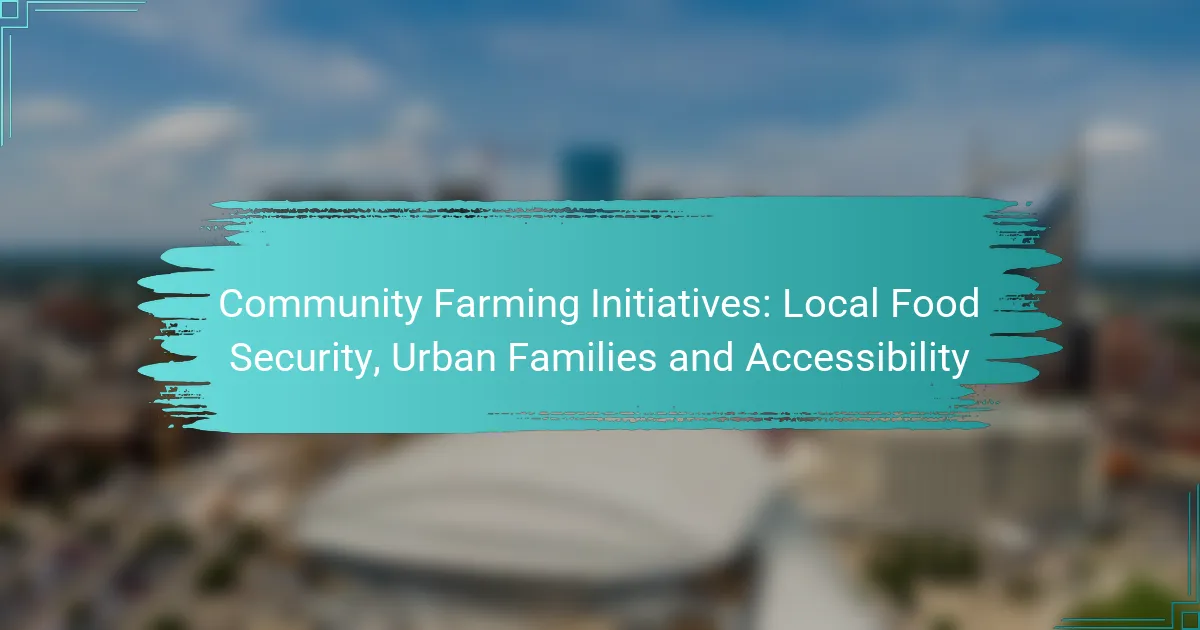Community farming initiatives play a crucial role in enhancing local food security for urban families by providing direct access to fresh and nutritious produce. These programs not only promote self-sufficiency and resilience but also create opportunities for social engagement, fostering a sense of belonging within the community. By participating in local gardens and workshops, families can strengthen their connections while contributing to sustainable food practices.

How do community farming initiatives enhance local food security in urban areas?
Community farming initiatives significantly improve local food security in urban areas by providing residents with direct access to fresh, nutritious food. These initiatives foster self-sufficiency and resilience within communities, reducing reliance on external food sources.
Increased access to fresh produce
Community farms offer urban families a reliable source of fresh fruits and vegetables, often at lower prices than conventional grocery stores. By growing food locally, these initiatives ensure that produce is harvested at peak ripeness, enhancing flavor and nutritional value.
Many community farms operate on a model where residents can participate in growing or harvesting, which not only increases access but also fosters a sense of ownership and community engagement. Programs like Community Supported Agriculture (CSA) allow families to subscribe and receive regular shares of fresh produce.
Support for local economies
Community farming initiatives stimulate local economies by creating jobs and supporting local businesses. When residents buy produce from local farms, they keep money circulating within the community, which can lead to further economic development.
Additionally, these farms often collaborate with local markets and restaurants, creating a network that prioritizes local sourcing. This not only boosts the economy but also promotes sustainable practices by reducing transportation costs and emissions.
Reduction of food deserts
Community farms play a crucial role in addressing food deserts—areas with limited access to affordable and nutritious food. By establishing farms in underserved neighborhoods, these initiatives provide essential food resources where they are most needed.
Moreover, community farms often include educational programs that teach residents about nutrition and cooking, empowering them to make healthier food choices. This holistic approach helps to combat the effects of food deserts and promotes overall community well-being.

What are the benefits of community farming for urban families?
Community farming offers urban families numerous benefits, including access to fresh produce, enhanced nutrition, and opportunities for social engagement. These initiatives not only improve food security but also foster a sense of belonging among participants.
Improved nutrition and health
Community farming enhances nutrition by providing families with fresh fruits and vegetables, which are essential for a balanced diet. Access to locally grown produce can lead to healthier eating habits, reducing reliance on processed foods that are often high in sugars and unhealthy fats.
Families participating in community farms can experience a significant increase in their intake of essential nutrients. For instance, incorporating a variety of vegetables into meals can improve overall health and help prevent chronic diseases.
Strengthened community bonds
Engaging in community farming cultivates strong relationships among neighbors, fostering a sense of community. Families working together towards a common goal build trust and camaraderie, which can lead to lasting friendships.
These initiatives often involve shared responsibilities, such as planting, maintaining, and harvesting crops, which encourages collaboration and communication. As families bond over their shared experiences, they create a supportive network that can enhance overall well-being.
Educational opportunities for children
Community farming provides valuable educational experiences for children, teaching them about agriculture, nutrition, and environmental stewardship. Kids can learn how to grow their own food, which instills a sense of responsibility and appreciation for nature.
Participating in these initiatives can also enhance children’s understanding of science and biology through hands-on learning. Activities like planting seeds and observing plant growth can spark curiosity and promote a lifelong interest in healthy living and sustainability.

How can families participate in community farming initiatives?
Families can engage in community farming initiatives by joining local gardens, attending workshops, and volunteering with food cooperatives. These activities not only enhance food security but also foster community connections and promote sustainable practices.
Joining local community gardens
Joining a local community garden allows families to grow their own food while connecting with neighbors. Participants typically pay a small fee for a plot and share responsibilities such as watering, weeding, and harvesting. Many gardens also offer resources like tools and seeds, making it accessible for beginners.
To find a community garden, check local government websites, social media groups, or community centers. Some gardens may have waiting lists, so it’s wise to apply early in the season.
Participating in urban farming workshops
Urban farming workshops provide hands-on learning experiences for families interested in sustainable agriculture. These workshops cover various topics, including soil health, crop rotation, and pest management, often tailored to local conditions. Many are offered for free or at a low cost by non-profits or local universities.
Look for workshops in your area through community organizations, local farms, or online platforms. Participating in these sessions can equip families with practical skills and knowledge to enhance their home gardening efforts.
Volunteering with local food cooperatives
Volunteering at local food cooperatives allows families to support food access initiatives while gaining insight into food systems. Many cooperatives welcome volunteers for tasks such as stocking shelves, organizing events, or assisting with community outreach. This involvement can lead to discounts on groceries and a deeper understanding of local food sources.
To get started, contact food cooperatives in your area and inquire about volunteer opportunities. Some may require a commitment of a few hours per week, making it manageable for families with varying schedules.

What are the challenges faced by community farming initiatives?
Community farming initiatives encounter several challenges that can hinder their effectiveness, including financial constraints, land access issues, and varying levels of community involvement. Addressing these obstacles is crucial for enhancing local food security and ensuring accessibility for urban families.
Lack of funding and resources
Many community farming initiatives struggle with insufficient funding and resources, which limits their ability to operate effectively. This can manifest as a lack of seeds, tools, or even basic infrastructure like water supply systems.
To mitigate this challenge, initiatives can seek grants from local governments, non-profits, or crowdfunding platforms. Establishing partnerships with local businesses can also provide essential resources and financial support.
Land access and zoning regulations
Access to suitable land is a significant barrier for community farming projects, often compounded by strict zoning regulations that limit agricultural activities in urban areas. These regulations can restrict where and how community farms can operate, making it difficult to find viable locations.
To navigate these challenges, community groups should engage with local authorities to understand zoning laws and advocate for more flexible regulations. Exploring underutilized spaces, such as vacant lots or rooftops, can also provide alternative solutions for farming.
Community engagement and participation
Effective community engagement is essential for the success of farming initiatives, yet many face challenges in attracting and retaining participation from local residents. Factors such as lack of awareness, time constraints, or cultural barriers can hinder involvement.
To foster greater participation, initiatives should focus on outreach efforts that highlight the benefits of community farming, such as improved food access and community bonding. Hosting workshops, events, and regular meetings can also help build a sense of ownership and commitment among community members.

How do community farming initiatives promote accessibility?
Community farming initiatives enhance accessibility by providing urban families with opportunities to grow their own food and access fresh produce. These initiatives often focus on creating inclusive spaces and resources that cater to diverse community needs.
Adaptive gardening techniques
Adaptive gardening techniques are essential for making community farming accessible to everyone, including those with physical limitations or varying skill levels. Techniques such as raised beds, container gardening, and vertical gardens allow individuals to participate without needing extensive gardening experience or physical strength.
For instance, raised beds can be built to a comfortable height, reducing the need to bend down, while container gardens can be placed on patios or balconies. These methods not only maximize space but also make gardening more manageable for urban families.
Programs for low-income families
Many community farming initiatives offer programs specifically designed to support low-income families, ensuring they have access to fresh, healthy food. These programs may include subsidized plots, free seeds, and educational workshops on sustainable gardening practices.
For example, some urban farms provide sliding scale fees based on income, allowing families to participate without financial strain. Additionally, food distribution programs may be integrated, enabling families to receive fresh produce directly from the farm at little to no cost.
Partnerships with local organizations
Partnerships with local organizations play a crucial role in enhancing the accessibility of community farming initiatives. Collaborations with schools, non-profits, and health agencies can help expand resources and outreach efforts, making it easier for families to engage with these programs.
For instance, a community farm might partner with a local health clinic to provide nutrition education alongside gardening workshops. These partnerships can also facilitate access to funding and grants, further supporting the sustainability of the initiatives and their ability to serve diverse community needs.
